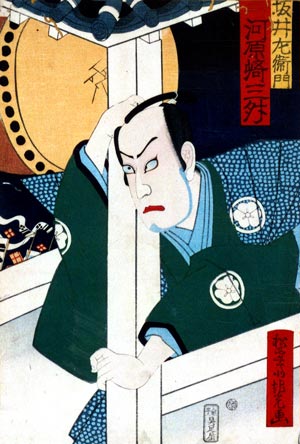| SAKAI NO TAIKO |
| Play title | Taiko no Oto Chiyû Sanryaku |
| Author | Kawatake Shinshichi II |
| History |
The drama "Taiko no Oto Chiyû Sanryaku", commonly called "Sakai no Taiko", was premiered in March 1873 at the Murayamaza [casting]. This play was written by Kawatake Shinshichi II in 1873, and is representative of a category of works called katsureki, "Living History" plays, which sought to depict past events as accurately as possible. Strict attention was paid to the correct way of speaking, as well as to proper behaviour, costume, make-up and character based on the then current research. The actor who championed these katsureki plays was Ichikawa Danjûrô IX, for whom the part of Saemon was originally written. "Sakai no Taiko" has rarely been performed since Danjûrô IX's time, though he himself thought enough of it to include it as one of his shin kabuki jûhachiban. "Sakai no Taiko" was also liked well enough for Danjûrô IX to revive it at least three times. Though katsureki was a very important development from an historical viewpoint, today many regard it as a phenomenon peculiar to the Meiji period and most of the plays are now felt to be boring. |
| Structure |
The original drama was in 4 acts. Only one act survived but is rarely staged nowadays. |
| Key words | Katsureki Taikôki Shin Kabuki Jûhachiban |
| Summary |
It is surely extremely difficult to act because the motivation of the characters is not necessarily expressed in the dialogue. In particular, Ieyasu says and does one thing but secretly means something completely different. Saemon too seems totally incompetent at his job and yet is the great hero of the play! It is what happens beneath the surface that's so important and, while the actors have to be very subtle in their portrayals, if they're not careful the audience simply won't know what's going on. It's essential to understand the background. It is the end of winter in the year 1572 and the country is in turmoil. Several warlords are taking advantage of this chaos to gain ever greater tracts of land for themselves to add to their power. As the play begins, it is Takeda Shingen who is attacking Tokugawa Ieyasu, (then, still under the protection of lord Oda Nobunaga). The action takes place at Ieyasu's stronghold, the small castle of Hamamatsu, and he himself has just returned from an unsuccessful battle that morning at Mikata-ga-Hara. All fear for their lives, yet Ieyasu himself, along with one of his loyal retainers, Sakai no Saemon, both seem unconcerned. When the other men went off to battle that day Saemon was left in charge of the castle, and he even appears to have drunk himself into a stupor. The whole play hangs on the idea of a bluff. Ieyasu knows full well that he and his followers are in terrible trouble and may well lose their lives. His apparent lack of concern is perhaps to comfort and encourage his people, whereas infact He's about to make one last-ditch attempt to save their lives. If that fails they are all lost. Despite being greatly outnumbered and though the enemy has advanced right up to the castle outskirts, he decides to leave the front gate wide open and to light bonfires for the enemy to see. Naturally, everyone thinks this idea insane and a valiant retainer called Torii Hikoemon even considers taking matters into his own hands. But he is stopped by Sakai Saemon. Saemon is drunk, yet he is the only one who seems to understand his lord's intentions. Courtesy of Paul M. Griffith |
 |
|
Kawarasaki Gonnosuke VII playing the role of Sakai Saemon in the drama "Taiko no Oto Chiyû Sanryaku", which was staged in March 1873 at the Murayamaza (print made by Shôsai Ginkô) |
|
|
| Contact | Main | Top | Updates | Actors | Plays | Playwrights | Programs | Links | FAQ | Glossary | Chronology | Illustrations | Prints | Characters | Derivatives | Theaters | Coming soon | News |